|
This article is cited in 17 scientific papers (total in 17 papers)
Review
Kinetic and electrical phenomena in gas–liquid systems
N. Yu. Babaevaa, R. S. Berryb, G. V. Najdisa, B. M. Smirnova, É. E. Sona, D. V. Tereshonoka
a Joint Institute for High Temperatures, Russian Academy of Sciences, Moscow
b Department of Chemistry, University of Chicago
Abstract:
Disperse systems consisting of a liquid and gas bubbles located in it are considered. Two possible versions of evolution of bubbles under the conditions studied are assessed. In simple liquids, contact between two bubbles causes them to merge, as the separating film breaks. In the case of complex organic liquids, amphiphilic film is formed on the surface of bubbles, and the lifetime of bubbles in contact increases with their size. Under an external electric field, chains of bubbles are formed, lined up along the electric field potential lines. The presence of bubbles in liquid greatly lowers the breakdown threshold, as the critical parameters of the breakdown field in liquids are two to three orders of magnitude higher than those in gases at atmospheric pressure. Various breakdown mechanisms in liquids are discussed from the viewpoint of formation of the gas phase during the passage of an electric current through a liquid medium. The character of propagating a streamer in separate bubbles is studied with their random distribution in liquid and in the case of formation of some structures of bubbles; the critical parameters of disperse systems, that can lead to their electrical breakdown, are presented. Along with the general concepts of electrical breakdown in dispersed systems, experimental studies of these processes are considered, and the nature of electrical breakdown in liquid dielectrics, including transformer oil, is discussed.
Received: 10.03.2016
Accepted: 15.03.2016
Citation:
N. Yu. Babaeva, R. S. Berry, G. V. Najdis, B. M. Smirnov, É. E. Son, D. V. Tereshonok, “Kinetic and electrical phenomena in gas–liquid systems”, TVT, 54:5 (2016), 792–816; High Temperature, 54:5 (2016), 745–766
Linking options:
https://www.mathnet.ru/eng/tvt10385 https://www.mathnet.ru/eng/tvt/v54/i5/p792
|


|





 Contact us:
Contact us: Terms of Use
Terms of Use
 Registration to the website
Registration to the website Logotypes
Logotypes








 Citation in format
Citation in format 
